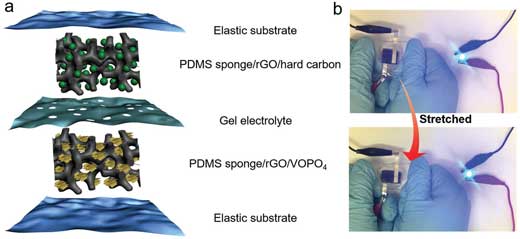| Posted: Apr 20, 2017 | |
Sodium-ion batteries become fully stretchable |
|
| (Nanowerk Spotlight) There is a growing demand for stretchable electronic devices, especially energy storage systems, which, in order to meet the requirements of day-to-day consumer use, need to maintain acceptable levels of electrochemical performance and mechanical properties simultaneously. | |
| However, these types of devices currently suffer from many problems, including low utility of active materials, limited multidirectional stretchability, and poor stability under stretched conditions. Furthermore, they usually fall short of making every battery component stretchable/flexible—typically only the electrodes are stretchable. | |
| In addition, studies on stretchable energy storage devices have mainly focused on lithium-ion batteries; other high-performance energy storage devices that integrate all-stretchable components, including electrode, separator, and battery package, have yet to be explored. | |
| In new work, researchers now have demonstrated an all-stretchable-component sodium-ion full battery, designed and manufactured by integrating a reduced graphene oxide (rGO)-modified PDMS sponge current collector, sodium-ion conducting gel polymer separator, and elastic PDMS substrate. | |
| The team, led by Professor Guihua Yu at the Texas Materials Institute, University of Texas at Austin, in collaboration with Professor Chris Ellison from the University of Minnesota, has published its findings in Advanced Materials ("An All-Stretchable-Component Sodium-Ion Full Battery"). | |
| "This first-of-its-kind battery design maintains better mechanical properties compared with most reported designs using one or more rigid components that fail to meet the stretchability requirement for the entire device," Yu tells Nanowerk. "Moreover, the electrochemical performance of our device rivals most previously reported stretchable energy systems." | |
 |
|
| a) Schematic illustration of the fabricated stretchable PDMS/rGO sponge/VOPO4//PDMS/rGO sponge/hard carbon sodium-ion full battery. b) Photographs of the stretchable sodium-ion full battery in the unstretched state (top) and stretched state with ∼50% strains (bottom) to power a commercial LED light. (Reprinted with permission by Wiley-VCH Verlag) (click on image to enlarge) | |
| Given these features, including high electrochemical performance and robust mechanical deformability, this stretchable battery is suitable to be implemented in various applications, such as conformable health monitoring skin sensors, wearable communication devices, roll-up displays, and implantable medical devices. | |
| "Our battery exhibits reasonable electrochemical performance and robust mechanical deformability," notes Yu. "Its electrochemical characteristics can be well-maintained under various stretched conditions after hundreds of stretching-release cycles." | |
| The team is confident that this graphene-modified PDMS sponge design offers a novel platform for not only stretchable energy storage devices but also energy conversion/harvesting devices. | |
 |
|
| Schematic of preparation steps of conductive PDMS/rGO sponge. While the PDMS/GO sponge (insulating) was brownish in color, once the material was reduced to rGO (conductive), the material appeared black. (Reprinted with permission by Wiley-VCH Verlag) (click on image to enlarge) | |
| Now that both the electrode substrate and battery package are made of PDMS, the strain limit is governed by the intrinsic material properties of the PDMS elastomer. To improve the stretchability beyond these limitations, Yu and his team are working with wrinkled PDMS substrates with pre-stretching, and trying to develop better 3D nanostructured elastomer. | |
| "We will focus on further improving the mechanical properties and electrochemical performance while at the same time lower the manufacturing cost," concludes Yu. "A reliable set of stretchable electrode and ion-conducting membrane is of key importance for stretchable electronics. We will continue our efforts in searching for promising electrodes as well as separator/membranes with significant mechanical durability and high electronic and ionic conductivity, to build stretchable energy-storage devices with better electrochemical performance and mechanical deformability." | |
 By
Michael
Berger
– Michael is author of three books by the Royal Society of Chemistry:
Nano-Society: Pushing the Boundaries of Technology,
Nanotechnology: The Future is Tiny, and
Nanoengineering: The Skills and Tools Making Technology Invisible
Copyright ©
Nanowerk LLC
By
Michael
Berger
– Michael is author of three books by the Royal Society of Chemistry:
Nano-Society: Pushing the Boundaries of Technology,
Nanotechnology: The Future is Tiny, and
Nanoengineering: The Skills and Tools Making Technology Invisible
Copyright ©
Nanowerk LLC
|
|
|
Become a Spotlight guest author! Join our large and growing group of guest contributors. Have you just published a scientific paper or have other exciting developments to share with the nanotechnology community? Here is how to publish on nanowerk.com. |
|
